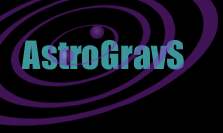
News /
Reports
Images & Movies
Links
Mock LISA Data Archive Tutorial
The Mock LISA Data Archive uses the LISA Simulator as a reference model for the LISA observatory. There is still some uncertainty about the precise form that the actual LISA data will take. Final decisions on the interferometry design, clock referencing, and sample cadence await further study. When necessary, the LISA Simulator will be upgraded to reflect design refinements and the adoptions of fixed coordinate conventions and data formats. These upgrades will then be reflected in the data found in the MLDA.Each mock data set contains a collection of reference files listing the source characteristics, how the source was modeled, and the LISA Simulator settings. The main data products are the X, Y and Z TDI signals. These include simulated detector noise and the fully modulated response of the detector to the input waveforms. Future releases of the LISA Simulator will also produce the Symmeterized Sagnac signal used for noise monitoring, but this data stream is not available in Version 2.0.
In addition to the main data products, a collection of secondary data files are included with each data set. For isolated sources each set typically includes h+ and hx at the Barycenter. These are the input files used by the LISA Simulator. They can be used to generate new output files by running the Simulator with different settings. Also provided are the interferometer outputs without instrument noise. These noise free data files are useful for producing new multi-source data files, or for looking at the same sources with multiple noise realizations. Multi-source data sets, such as realizations of the galactic background, do not have a corresponding h+ and hx Barycenter signal as the sources are at different sky locations.
The key quantities to look for in the reference files are the duration of the observation, the sample cadence, and the initial orientation of the observatory. The duration and cadence are crucial as the various outputs are given as time ordered lists with no explicit time reference for each data point. The initial orientation of the observatory is defined by the parameters kappa and lambda defined on the LISA Simulator website. These numbers are important if you want to produce matched filters, or if you intend to combine multiple data sets.
Combining Data Sets
We expect the LISA response to gravitational waves and instrument noise to be linear. This allows us to form combined data sets by co-adding the response to individual sources. For example, one may want to look at the signal from a supermassive black hole binary in the presence of a galactic background. Or, one may want to study a particular signal with many different noise realizations or noise levels.With a little caution, different data sets in the MLDA can be combined together to provide challenging tests for your data analysis procedures. First, make sure that the data sets use the same initial detector orientation (kappa,lambda), and that they are for the same TDI variable (i.e. don't add X signals to Y signals etc). Check to see if the data stream includes noise. It is best to add together signals with no detector noise, then add in a noise realization at the end. Doing otherwise leads to an over estimate of the detector noise level. Next, look at the observation time and sample cadence. If these are the same you may go ahead and co-add the signals. When the duration or sample cadences differ, there is more work to be done before the signals can be added. Consider the following examples.
Example 1.
Data set A has a 1 year duration and 223 samples spaced 3.76202 seconds apart. Data
set B has a 1 year duration and 225 samples spaced 0.940505 seconds apart. The
easiest way to combine these data sets is by adding their Fast Fourier Transforms (you have to
pad the FFT of data set A with zero's above its Nyquist frequency of 0.133 Hz).
Example 2.
Data set A has a 1 year duration and 223 samples spaced 3.76202
seconds apart. Data set C has a 1.06326 year duration and 225 samples spaced 1.0
seconds apart. Use a cubic spline to interpolate data set C into 225 samples spaced
0.940505 seconds apart for one year of observations (i.e. throw out the extra 0.06326 years
worth of data). Then follow the procedure described in Example 1.
Warnings: When adding data sets of different duration, you always have to round down to the shortest duration. Otherwise there will be signals that abruptly stop, which will cause ringing in the Fourier domain. When adding data sets with incomensurate sample spacings, as described in Example 2, the interpolation procedure can introduce spurious high frequency features. You might want to consider applying a low pass filter.
Sources classes